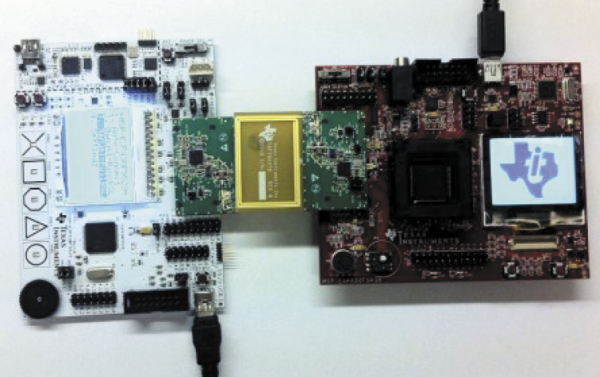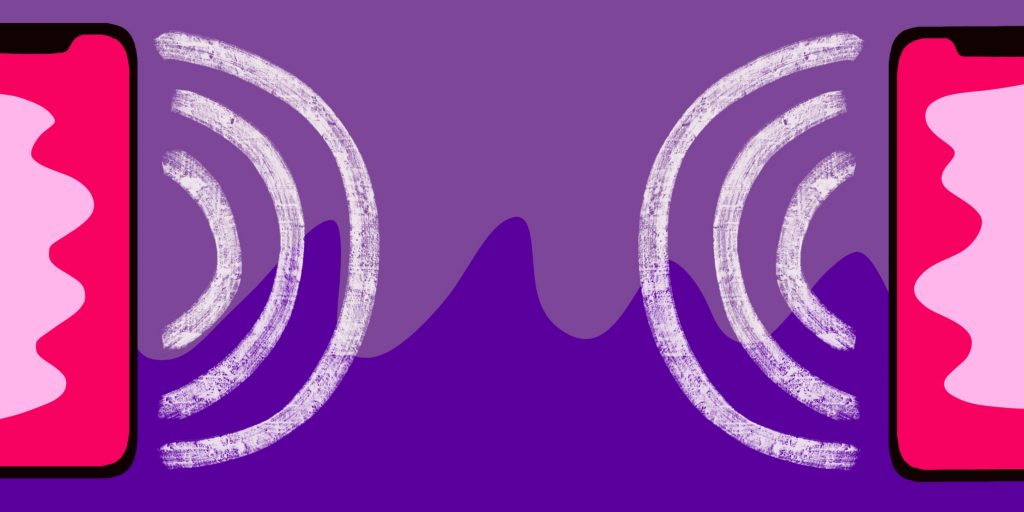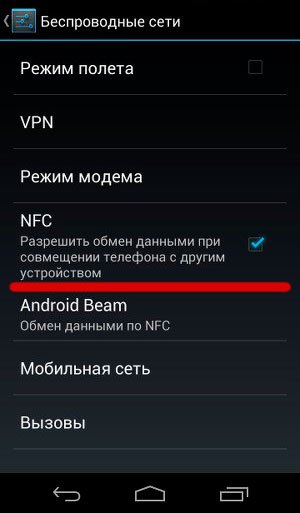NFC communication
NFC allows data exchange between devices at a relatively high speed, comparable to BLE and ZigBee technologies, but effective distances rarely exceed a few tens of centimeters (Figure 1). On the one hand, this limits the scope of application to personal devices or cards, on the other hand, due to the limited range, the security of data exchange is slightly increased. In addition, in some cases, NFC devices do not need a power source.

Fig. 1. Approximate scopes of wireless interfaces of various standards
NFC applications to date include:
- non-cash payments;
- payment for travel in municipal transport;
- time tracking and execution control systems;
- identification and access control systems;
- interactive stands and posters;
- Set Bluetooth or Wi-Fi devices to work together.
Bluetooth and Wi-Fi interfaces have become almost standard for modern phones, smartphones and tablet computers, allowing interaction with headphones, cameras, microphones. With a large number of gadgets, quickly setting up communication between the right devices can be a problem.
For example, to connect a device to a smartphone or tablet via Bluetooth, it must be put into the connection search mode, usually by pressing or holding a certain button. Then you need to select it on your smartphone from the list of available devices, and it can be quite long.
NFC allows you to significantly simplify this process – to establish a connection between devices, it will be enough to bring them to each other for a short time. In addition, after the connection is established, the required application can be automatically launched. The N FC Forum™ and the Bluetooth SIG have jointly developed the Bluetooth Secure Simple Pairing using NFC document, which defines a message format for establishing a connection (called “pairing”) between Bluetooth devices through NFC devices.
There are two connection establishment modes:
- direct connection, during which the connection parameters are transferred, the connection establishment procedure and the setting of the data transmission channel between two devices are monitored;
- indirect connection, when an NFC smartphone or tablet acts as an intermediary for transferring connection parameters between the device and its connection point (for example, between a laptop and a wireless access point).
In addition to helping to establish a connection between devices, NFC can play the role of a simple and cheap service interface:
- an NFC-enabled smartphone or tablet can act as a universal display for displaying device status or as a console for its administration and configuration;
- wireless connection does not require special connectors, and the use of a radio channel allows you to abandon the transparent windows that are typical for infrared ports;
- contactless firmware update or regional adaptation of the product directly in the package is possible.

The NFCIP standard – Near Field Communication Interface and Protocol – contains two parts NFCIP-1 and NFCIP-2. N FCIP-1 [1] is standardized in documents ISO/IEC 18092, ECMA 340, ETSI TS 102190. It defines two exchange modes – active and passive, determines the frequency bands, modulation types and data rates (106, 212, 424 kbit/ c), device discovery and communication procedures.
NFCIP-2 [2] is standardized in ISO/IEC 21481, ECMA 352, ESTI TS 102312 and defines interoperability mechanisms for devices of ISO 18092, ISO 14443, ISO 15693 operating in the 13.56 MHz band.
The technology can also be used to transfer files.
To transfer data, you need to do the following steps:
- make sure that you have completed the activation of NFC and Android Beam;
- unlock the device, exit “sleep mode”;
- check device detection with each other;
- connect;
- transfer data between devices;
- a specific beep will sound at the end.
What should I do if the device does not support NFC?
The standard defines three possible modes of operation for NFC devices:
- point-to-point mode;
- card emulation mode;
- reader mode.
Point-to-point mode provides bi-directional communication between devices. In this case, each of the devices can, if necessary, initiate an exchange.
In card emulation mode, the NFC device functions as a proximity card/tag.
The reader can read and write data to NFC/RFID devices and contactless cards, as well as power passive NCF devices.
The bootstrap loader (BSL) allows access to the MSP430’s memory during prototyping, to update the controller firmware in the finished product, and to service the device. While in the lower series controllers of the MSP430 BSL family (Figure 4) the bootloader is located in ROM memory and is read-only, in the MSP430F5xx and MSP430F6xx series the bootloader is located in a protected area of the FLASH memory [6]. This not only provides him with memory erasure protection, but also allows him to perform the following tasks:
- use various protocols and interfaces such as UART, USB, SPI, I2C, NFC, and sub-1GHz;
- assign various events to trigger BSL, up to pressing a button;
- add checking the integrity of uploaded or uploaded data and code, for example, by calculating a checksum (CRC);
- change the baud rate.

Fig. 4. MSP430 BSL bootloader structure
The bootloader itself consists of three main parts:
- peripheral interface (PI), which receives and decodes bootloader commands, and also contains drivers for the main interfaces – UART and SPI (in particular, you can interact with the bootloader via the TRF7970A transponder);
- a command interpreter (CI) that receives and executes commands;
- BSL API – a set of functions that is an intermediate link between the command interpreter and the controller’s built-in memory.
Given the 2KB bootloader size limit, NCF BSL only supports a small part of the NFC protocol needed for simple data transfer operations.
The target device is initially in the passive standby mode provided by the TRF7970A when the Single Device Detection (SDD) mode is activated, which reduces memory requirements. The data rate when establishing a connection is 106 kbps. The attribute request packet and its response (Attribute Request – ATR_REQ and Attribute Response – ATR_RES respectively) complete the connection establishment process.

The flashing speed is quite comparable with the speeds of work through the COM port (Figure 5). (The example uses MSP-EXP430F5529 and MSP-EXP430F5438 development boards with TRF7970ATB NFC boards connected to them).

Fig. 5. Firmware update via NFC BSL
Don’t worry if you don’t find the built-in function, there is a way to connect NFC to your device. But you can only do this if the panel cover on the back and the SIM card slot on your smartphone/tablet are removable. Installing NFC in this case is not difficult.
The best solution is to install a special module – an external communication device. It is compatible with almost all smartphones, easy to use and gives you access to NFC without buying a new phone.
Main types: chips, SIM cards, external devices, stickers. The last of them are of two types: passive – which do not allow data to be exchanged, and active – use Bluetooth and Wi-fi communication channels for transmission, which significantly increases energy consumption.
These stickers are attached to the outer shell of the phone, which is also not very practical.
The most popular are the following:
- NFC SIM. Now available for purchase from most mobile operators. You can find out about the availability of such a SIM in the communication salon. You only need to install the finished card in your phone or tablet. This type of module is the most affordable and easy to install.
- NFC antenna. The second way, for which you will need to purchase an NFC antenna. You can do this in the communication salon. Next, the antenna is attached to the SIM card and inserted into the device.

As you have already seen, installing the module is quite simple and safe: you do not need to download additional applications or programs. However, these services do not completely replace the Android Pay app, but are just some of its many features.
An NFC tag is a miniature device in the form of a chip that can be attached almost anywhere: from the phone to being inserted under the skin!
We will not use such radical methods, but it is worth noting that contacts, settings, a URL and other data and commands can be placed on the chip. All gadgets can support the tag.
In order to read data from such a device, you need to find a specialized official application on Google Play and then, after installation, you can give the tag various commands for execution.
Texas Instruments NFC Solutions
Texas Instruments provides a wide range of near field communications products to meet virtually every market need today [3]. The company’s NFC hardware solutions include the highly efficient and flexible TRF7970A and RF430CL330H transponders, the RF430FRL15xH single-chip systems, and the RF430F59XX packaged systems with MSP430 processor cores.
How to check if there is NFC?
This technology can be found not only on smartphones, but also on other devices, for example, tablets also have similar functionality. The NFS receiver occupies a minimum of space and is usually “comfortably” placed between the battery and the body cover of the device. How do you know if your equipment has such an innovation?
Speaking of other objects, readers and writers can be embedded in other products used in everyday life. This technology is used when paying for travel cards in public transport. In household appliances, modern refrigerators with smart functions are the first in the frequency of use.
This can be said about both hardware and software developers, so new devices and software are being released more and more often, allowing highly efficient use of NFS.
It is worth noting that this technology is supported by Android operating systems version 4.0 and higher, as a function built into the Beam system. In order to check the presence of the module on your phone, you need to go to its settings, select the wireless networks item and click on “More” (Advanced.).
If the NFC item is checked there, you can be congratulated, the phone supports the standard, and you are reading this article for a reason. To activate its work, you just need to check the box next to this “cherished” item.
Wanted to try the technology in practice, but don’t know if this is possible on your device? Let’s check.
To do this, carefully open the back cover of a smartphone or tablet, in a situation where it can move away without damage and inspect the gadget’s battery.
In the presence of NFC development, you will see this abbreviation there. If the cover of the phone/tablet is not removable, then the corresponding icon or abbreviation will be located on the outside.
If for some reason you do not want or cannot remove the cover, you can make sure that such a communication method is available in the device settings.
Find the “Wireless networks” tab, then “More …” and if NFC is available on the device, then there will definitely be a corresponding item.
RF430FRL15xH series transponders
The TRF796xA and TRF7970A [5] are high performance 13.56 MHz transceivers with built-in packetizers supporting ISO/IEC 15693, ISO/IEC 18000-3, ISO/IEC 14443A and B (Figure 3).

Fig. 3. Structural diagram of transceivers TRF796xA, TRF7970A

TRF7970A, as the latest member of the TRF79xxA family of transceivers, supports the NFC standards NFCIP-1 (ISO/IEC 18092) and NFCIP-2 (ISO/IEC 21481).
Built-in blocks of data encoding-decoding, packet formation, as well as a large FIFO buffer make it quite easy to interact over the air. The field presence detector can wake up the device from sleep mode, thus optimizing the overall power consumption of the device. Depending on the situation, mode of operation, application, TRF79xxA can be in one of the seven available power modes.
A wide range of allowable supply voltages of 2.7…5.5 V allows the use of the transponder in devices with different voltage levels – both in devices with logic levels of 3 V and with 5 V devices. It is also possible to operate the transponder with a heavily discharged battery nutrition.
The TRF79xxA transceiver allows implementing various exchange protocols for the 13.56 MHz band, including non-standard ones.
Key features:
- support for ISO 14443A, ISO 14443B, ISO 15693, ISO/IEC 18000-3 (Mode 1);
- supply voltage range 2.7…5.5 V;
- built-in power regulator (output current up to 20 mA);
- consumption in standby mode – 120 μA, in sleep mode – less than 1 μA;
- parallel or serial (SPI) interface with the host system;
- built-in packetizer, checksum checker, parity checker;
- data transfer rate – up to 848 kbps;
- clock output for host controller;
- programmable antenna amplifier;
- output amplifier with support for OOK or ASK modulation;
- programmable output power – 100 or 200 mW;
- receive and decode multiple subcarriers.
RF430FRL15xH [7, 8] is a 13.56 MHz transponder with a built-in 16-bit low-power MSP430 controller (Figure 6). Non-volatile random access memory of FRAM technology is used for program and data storage.

Fig. 6. Structural diagram of RF430FRL15xH series transponders

FRAM is effective in NFC applications due to its high speed and low power consumption combined with data retention when power is turned off. The non-volatility of the built-in FRAM-memory RF430FRL15xH allows this transponder to be freely used both in self-powered applications and in applications powered by the external electromagnetic field of the reader.
The RF430FRL15xH supports communication, parameter setting and configuration via wireless interface (ISO/IEC 15693, ISO18000-3 standards), as well as via SPI or I2C interface.
Built-in temperature sensor, low power 14-bit ADC, two configurable analog amplifiers allow the RF430FRL15xH to be used as a stand-alone sensor node serving both digital and analog sensors.
Basic transponder features:
- radio interface ISO/IEC 15693, ISO/IEC 18000-3 (Mode 1);
- power supply selection: external power supply or electromagnetic field;
- built-in temperature sensor, interface to resistive sensor;
- 16-bit checksum calculation (CRC) block;
- MSP430 microcontroller core (2K FRAM, 4K RAM, 8K ROM);
- supply voltage – 1.45 … 1.65 V (current consumption 260 μA / MHz, in power saving modes – 9 … 15 μA);
- multiple clock sources (4 MHz, 256 kHz, external clock);
- eUSCI interface module supporting SPI and I2C;
- JTAG debug interface.
NFC activation
If you found it on your device, you must also activate access to NFC technology. You can do it like this:
- go to the “Settings” section and then “Wireless networks”, “More …”, where earlier you could make sure that NFC is available;
- confirm by clicking on the item “Allow data exchange when combining {amp}gt; device name {amp}gt; with another”;
- Android Beam is immediately activated on an Android smartphone. If this does not happen, click on it and select “Yes” so as not to disrupt the system;
NFC debugging tools
Traditionally, Texas Instruments offers a range of debug and demo kits [10].
Dynamic NFC Transponder Evaluation Kit consisting of RF430CL330HTB Target Board and MSP-EXP430FR5739 can be used to evaluate, debug and validate NFC applications.
The NFCLink Evaluation Kit Bundle contains the TRF7970ATB Target Board, MSP-EXP430F5529 USB Experimenter’s Board, RF430CL330HTB Target Board, and MSP-EXP430FR5739 Experimenter Board (Figure 8).

Fig. 8. NFC debug kits TRF7970ATB Target Board (a) and NFCLink Evaluation Kit Bundle (b)
The TRF7970ATB Target Board can be paired with one of the MSP430™, Tiva™ C, or OMAP™ controller target boards.
Advantages and disadvantages of NFC

The main advantages are:
- low price;
- small dimensions of the device;
- high transmission speed;
- support on almost all mobile devices.
It is worth highlighting the cons:
- relatively small range;
- Not all devices are equipped with an NFC chip.
So, thanks to these notes, you have learned quick and easy ways to test your device for the ability to transmit information and interact with other technical means using Near Field Communication. By following the simple instructions in this article, you will also be able to find out for yourself if your smartphone has this technology, you will be able to integrate NFC into your phone and transfer the necessary files at high speed.
NFC Link SW software package

Fig. 9. Structure of the NFC Link software package
The main software library for working with NFC devices of the TRF79xx series manufactured by Texas Instruments is the NFCLink software package) [11, 12]. Its structure is shown in Figure 9.
NFCLink supports Texas Instruments MSP430™, Tiva™ C, and OMAP™ families of embedded controllers and consists of the following parts:
- drivers for working with TRF79xx;
- set of NFC, RFID API functions;
- host system interface (NFC Controller I/F – NCI), including support for Android, Linux and Windows® 7 and 8 operating systems.
The modular structure of the NFC Link package makes it easy to select the right components and functions required in a particular application. Also, this package allows you to create applications that go beyond the standard NFC protocol using the hardware capabilities of TRF79xx transponders.

The main part of NFC Link is supplied in the form of precompiled libraries, and the application for the interaction of the host system with TRF79xx transponders (interface layers) is in the form of source codes.
Conclusion
Texas Instruments provides hardware and software for developing NFC and RFID devices.
The Texas Instruments product range includes hardware – NFC receiver chips, transponders, transceivers, as well as software solutions for integrating NFC devices into systems. All this helps to reduce the complexity of the process of developing a new product and reduce the time it takes to bring it to the market.
COMPEL, which is the official distributor of Texas Instruments in Russia, provides technical support to developers and manufacturers.
 NFC Expert
NFC Expert